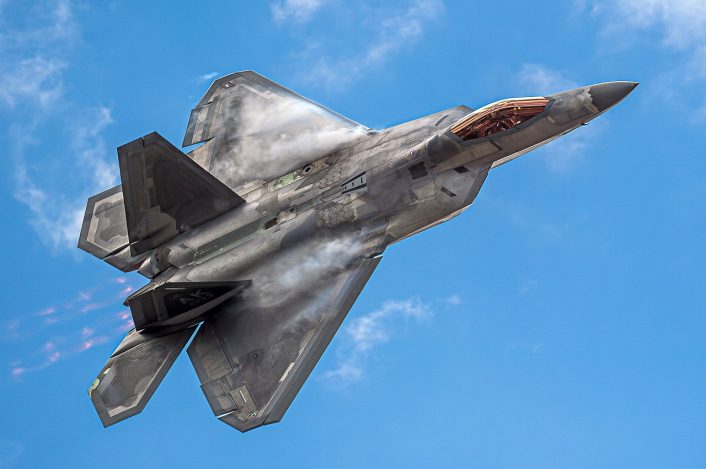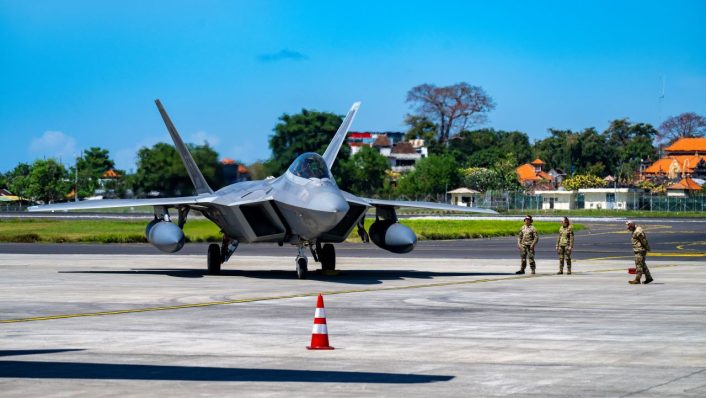The contract follows the recent news about the tests of new advanced sensors on the F-22 Raptor, which the U.S. Air Force is planning to field quickly as part of the ongoing upgrade program.
Amid the acute need for 5th generation fighters in modern combat scenarios against peer adversaries, the U.S. Air Force is looking to upgrade its F-22 Raptor with a series of sensors to make it more survivable and relevant. The service announced on Aug. 29, 2024, the award of a $1 billion contract to RTX‘s Raytheon for new sensors that are categorized as “Group B hardware”, together with spares and support equipment.
“Work will be performed in McKinney, Texas, and is expected to be completed by May 8, 2029,” said the DoD contracts statement. The Aviationist had recently reported that the Air Force was testing new sensors on the F-22 to extend its service life, which would also be applied to the NGAD (Next Generation Air Dominance) family of systems.
That report also quoted Brig. Gen. Jason D. Voorheis, the Program Executive Officer for Fighter and Advanced Aircraft, who said they were hoping to field these sensors faster. The Raptor team had conducted six flight tests to demonstrate the advanced sensors.
“The F-22 team is working really hard on executing a modernization roadmap to field advanced sensors, connectivity, weapons, and other capabilities. We’re executing that successfully, and that will lead to […] a rapid fielding in the near future.” This would be done through a Middle Tier Acquisition (MTA) program.
Some of the sensors included in the contract could be the stealthy pods seen on the F-22. Air and Space Forces earlier quoted officials who confirmed that the pods host IRST (Infrared Search and Track) sensors. The development of a new IRST sensor for the Raptor was also confirmed by the service’s 2025 budget request, which however did not mention the sensor being podded.
This work is part of an F-22 improvement campaign that calls for $7.8 billion in investments before 2030, which includes $3.1 billion for research and development and $4.7 billion in procurement.

F-22’s future in the U.S. Air Force
The development is also in contrast with previously reported USAF plans to retire the older F-22 airframes, for which it had sought approval from the Congress. These F-22s are 32 Block 20 units from a total fleet of 186. At the same time, the service aims to upgrade the remaining 154 with new cryptography, an expanded open architecture, new weapons and an advanced threat warning receiver, beside the IRST.
However, the service now appears to be reconsidering that plan, after Voorheis was quoted in the ASF report: “From an F-22 sunsetting perspective, I don’t have a date for you.” “What I can tell you is that we are hyper-focused on modernization to sustain that air superiority combat capability for a highly contested environment for as long as necessary,” he added.
IMAGE 3: A U.S. Air Force F-22 Raptor assigned to the 3rd Wing takes off above Joint Base Elmendorf-Richardson, Alaska, Jun. 17, 2024. (Image credit: USAF/Senior Airman Julia Lebens)
The U.S. Air Force describes the Raptor as a combination of stealth, supercruise, maneuverability, and integrated avionics, designed to project air dominance, rapidly and at great distance. Initially introduced as an air-superiority-only asset, the F-22 later started performing both air-to-air and air-to-ground missions.
The F-35 is largely a strike fighter and an airborne sensor-fusion and data-processing capable command post in its tactical orientation. But the Raptor is a pure air dominance interceptor. Although costly to upgrade and maintain, it nevertheless can play an important role in degrading adversary air power through either long-range BVR (Beyond Visual Range) and dogfights.
Moreover, having F-22s also increases the number of LO (Low Observable) aircraft in the inventory, at least until more F-35s are available, especially the TR-3 (Technology Refresh-3) Block 4 upgraded variants.
In 2021 too, then Air Force chief General Charles Q. Brown Jr. revealed his “4+1” fighter plan, suggesting the F-22 to be replaced by the NGAD while retaining the F-35, F-15E and EX, and the F-16. The “plus 1” was the A-10, but in March 2023, Brown said the A-10s were being retired faster than expected and the entire fleet would possibly be divested by 2030.
Meanwhile the NGAD’s future itself is uncertain after U.S.A.F have noted its technical complexity and financial implications. The F-22 thus seems to be back in the running.
On Jul. 10, 2024, Air Combat Command chief Gen. Kenneth Wilsbach said during a Mitchell Institute event that the service has no official plan to retire its F-22 Raptors. “Right now, there’s…frankly isn’t an F-22 replacement and the F-22 is a fantastic aircraft,” said Wilsbach. “I’m in favor of keeping the Block 20s. They give us a lot of training value, and even if we had to in an emergency use the Block 20s in a combat situation, they’re very capable.”

Other known F-22 upgrades
Other upgrades mentioned in the 2025 budget request are a Mode 5 Identification Friend or Foe (IFF), Link 16, a Multifunction Information Distribution System Joint Tactical Radio System (MIDS JTRS), a new Operational Fight Program, advanced radar Electronic Protection and an Embedded GPS/Inertial Navigation System (INS) Modernization (EGI-M).
Voorheis also mentioned the GRACE (Government Reference Architecture Compute Environment) software that would allow “non-traditional F-22 software” to be installed on the aircraft and provide “additional processing and pilot interfaces.”
A new helmet is also being tested, as part of the Next Generation Fixed Wing Helmet program to replace the current 40-year-old HGU-55P headgear. The new helmet would also allow the introduction of helmet-mounted devices which provide essential flight and weapon aiming information through line of sight imagery, easing the workload of the pilots.









